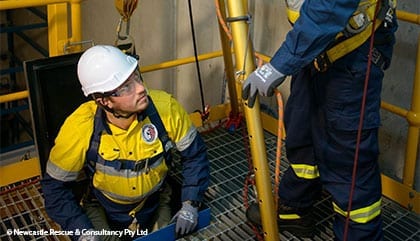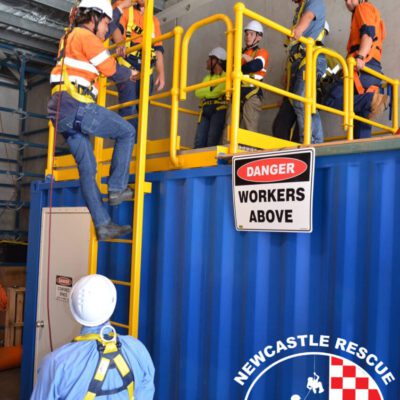Confined Space Rescue Plan

When was the last time you reviewed the confined space rescue capability at your workplace? Do you have a documented and rehearsed rescue plan, with adequately trained rescue personnel, and the capability to rescue an injured person from a confined space if an emergency occurs?
Companies must ensure that adequate emergency procedures are in place for all confined space entries, and that these emergency procedures are documented and regularly rehearsed. For your organisation to have a well-developed confined space rescue capability, you should have the following 3 key measures in place:
- A confined space rescue plan is completed for every confined space entry that occurs
- Confined space rescue training is undertaken by relevant personnel based on the site-specific hazards and risks
- Confined space rescue exercises form part of the overall emergency management and emergency prepared strategy for your workplace
1. A confined space rescue plan is completed for every confined space entry that occurs
All confined space entries are different, and each requires a documented emergency response plan that covers the types of emergencies that may occur, and the specific rescue procedures to be followed in the event of an emergency. The rescue plan should be written by a competent person who analyses the confined space work, the types of emergencies that are foreseeable, and the emergency rescue procedures to be implemented.
By having an effective confined space rescue plan in place (which should be attached to the confined space entry permit at the confined space entry location), you can ensure that if an emergency occurs, a safe and effective emergency response can be undertaken that has been documented. This prevents rescues being undertaken without proper planning, that could expose rescuers to hazards that they are not aware of.
Generally, a confined space rescue plan should cover at least the following:
- Activation of the rescue plan (who will activate the emergency response, and who will attend, who will contact emergency services)
- PPE required by the rescue team prior to entry (e.g. SCBA, Harnesses etc.)
- Rescue Method (Non-entry rescue such as a tripod and winch, or an entry-rescue that may require rescue personnel to wear breathing apparatus and other Personal Protective Equipment)
- Pre-positioned rescue and first aid equipment required, inspection of equipment, and location of equipment and anchor points etc. (e.g. Tripods, Harnesses, Stretchers, rope rescue equipment, breathing apparatus equipment, gas detectors, communication equipment etc.). NOTE: Consideration should be given to locating this equipment at the confined space entry and pre-rigging equipment where practicable
- How the casualty will be extracted from the incident to medical assistance, and who will provide the medical assistance
- Does the complexity of the rescue plan require the confined space entrants to wear specific PPE such as a confined space harness throughout the work, or do workers need to remain attached to ropes or winch lines as an additional safety consideration.
- Specific hazards and control measures that must be known and understood by the rescue team prior to entry, such as isolations. The rescue team must also review the confined space entry permit prior to entry)
NOTE: If the assessed work within the confined space changes, or if items of rescue equipment noted within the rescue plan are not available on the day of the work, then the confined space work should stop until a new rescue plan is completed.
2. Confined space rescue training is undertaken by the relevant personnel based on the site-specific hazards and risks
The selection of the type of confined space training to be carried out must be based on the types of confined space rescue scenarios that your personnel may be required to respond to. Expert advice should be sought to ensure that the confined space training is based on the types of rescues that must be undertaken, and the equipment available. Confined space rescue courses are normally 3-5 days in duration (depending on the modules covered) and normally comprise the following subjects:
- Confined Space Hazards and Control Measures
- Confined Space Rescue Systems (rigging rope rescue systems, use of tripods and davits, stretcher usage, anchor points and re-directions etc.)
- Rescue team duties, rescue size-up and planning (Team leader, safety officer, rescue team members)
- First Aid and Patient packaging knowledge and skills
- Breathing Apparatus usage in emergency response environments (Self-contained breathing apparatus and/or airline breathing apparatus operations in areas of restricted movement)
- Gas detection knowledge and skills
- Various practical rescue scenarios based on the specific hazards of the workplace
Confined space training should involve an emphasis on practical rescue skills, rigging skills, and patient packaging skills. Multiple scenarios should be run so that rescue team members can apply their skills and knowledge to varied scenarios and participate in the various rescue team member roles. At the end of the course, participants should be able to respond to reasonably foreseeable confined space rescue situations on-site, develop a rescue plan, and complete a rescue of injured personnel within a confined space environment. Training should be refreshed at least annually to retain core skills.
3. Confined Space Rescue exercises form part of the overall emergency management and emergency preparedness strategy for your workplace
For confined space rescue teams to conduct safe rescues of injured patients from a confined space, exercises must occur regularly. Confined space rescue exercises give rescue teams the ability to hone their knowledge, skills, and experience in a variety of circumstances. Rescue scenarios should mirror real world site-specific scenarios that may occur at your workplace and make use of actual workplace confined spaces wherever practicable.
Where possible, have confined space rescue exercises supervised by a confined space rescue trainer who can provide practical guidance and feedback to improve the performance of the rescue team. Plan out the exercises a year ahead, involve your safety team, and have the goal of increasing the complexity of the rescue exercise on each occasion to develop the rescue team’s skills.
Summary
Confined space rescues are a very technical form of rescue, that often involves setting up complex rope rescue systems, utilising breathing apparatus equipment, and utilising gas detection equipment. To ensure that you have a tried and tested capability to rescue injured personnel from confined space emergencies, ensure that you put in confined space rescue plans, appropriate confined space rescue training, and regularly carry out confined space emergency response exercises.
John Owen
Managing Director
View our 3 day Confined Space Rescue Training
For more information on Safework Code of Practice

